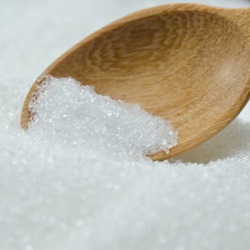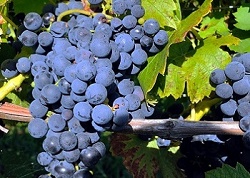Wine Content
Typical Wine Content:
|
|
Grapes
Different grapes, yeasts, and production methods create different styles of wine.
Vitis Vinifera is the most used grape family because it produces higher quality wines and better aromas.
Red wines are made from red grapes:
White wines are made from white grapes:
Sweetness (Sugar)
The sugar in wine is in the grape juice.

Dry Wines
Some residual sugar 2-8 g/l (grams sugar per liter)
Medium Wines
Residual sugar 8-12 g/l
Sweet Wines
50-200 grams per liter
Dry Wines Most of the wines on the market are dry. A wine becomes dry when the yeast converts all sugar into alcohol during fermentation.
Medium Wines A medium-dry wine tastes a little sweet because the yeast has not converted all sugar into alcohol. Most medium-dry wines are white (Riesling, Moscato) or rosé wines (White Zinfandel).
To make a medium-sweet wine either you remove yeast before it consumes all the sugar, or you add unfermented grape juice (must) to a dry wine.
Sweet Wines Sweet wines can be produced from grapes that are extreme high in sugar (late harvest) or by killing the yeast before it has consumed all the sugar in the grapes.
Sauternes and Ice Wine are sweet wines.
Acidity

High acidity
Medium acidity
Low acidity.
High acidity gives a wine a crisp and fresh taste.
Low-acid wines taste more smooth and round.
Acidity gives a wine a fresh taste. It makes your mouth water.
Acidic wines taste refreshing and crispy.
Low-acid wines taste smooth and round.
In medium (off-dry) and sweet wines, acidity balances the taste of sweetness avoiding unpleasant extra sweet taste (e.g. Riesling).
Acidity does not come from the skins but from the grape juice and ranges from 2.5 to about 4.5 in the PH spectrum.
The most common acids in wine are tartaric acid, malic acid, and citric acid.
Acidity is a key factor in long-term aging, but it is forbidden to add acid during winemaking (it is not forbidden in the New World).
Examples of high acidic wines are: Riesling, Pinot Noir, Chablis, most Italian wines.
Tasting terminology for acidity: crisp, zesty more for white wines, tart more for red wines. Tangy, sharp, tingling, aggressive, mouth-watering.
Acidity in White Wines
| Gewürztraminer | |
| Pinot Gris | |
| Chardonnay | |
| Bordeaux Blanc | |
| Sauvignon Blanc | |
| Riesling | |
| Chablis | |
| Pinot Grigio | |
| Dry Chenin Blanc |
Acidity in Red Wines
| Grenache | |
| Malbec | |
| Rioja | |
| Merlot | |
| Shiraz | |
| Syrah | |
| Gamay | |
| Pinot Noir | |
| Chianti | |
| Sangiovese | |
| Barbaresco | |
| Barbera | |
| Barolo | |
| Chianti | |
| Nebbiolo |
Tannins
Tannins are small bitter particles found in trees and plants.
In wines they come from grape skins, stems, seeds, and oak barrels.
Tannins are present in red wines, almost never in white wines.

High tannins
Bold red wines
Medium tannins
Medium red wines
Low tannins
Light red wines
No tannins
White wines
What do Tannins Taste?
You cannot taste tannins but you can feel them:
Try to chew on: Grape Seeds, Tea Leaves, Walnuts or Banana Skin, and you can feel a dryness in your mouth and a bitterness on your tongue.
Tannins refers to using bark (Latin tannum = oak bark) for tanning animal skin into leather.
Yeast
Grape skins have wild yeast growing on them and it starts a spontaneous fermentation.
The cultured yeast is made in laboratory and the most common species is Saccharomyces Cerevisiae.
Commercial yeasts are flavor-active: they influence the outcome creating a "yeast bouquet".
Anthocyanins
From Greek: Anthos (flower) and Kyanous (dark blue).
Anthocyanins (or Anthocyans) are color pigments found in plants, flowers, berries, fruit and vegetables. Depending on the PH, the colors can be red, orange, violet, purple, blue, or black.

Picture by Harvard.Edu
Wine grapes are very rich in Anthocyanins.
Scientific studies show benefical effects with antioxidative and antimicrobial effect, improve visual, neurological and cardiovascular health.
Anthocyanins is an antioxidant that fight the effects of aging and oxidative stress.
Plants produce Anthocyanins as a protective mechanism: resistance to predators (bugs, birds, rodents) and environmental stressor (UV rays, cold temperatures, drought).
Stabilisers
Sulphur is the most common antioxidant used in wine production. It can be added to the wine at any stage of the winemaking process. Sulphur kills any unwanted bacterias or yeasts that are leftover from the winemaking process.
Fining Agents / Clarifiers
The purpose of using a fining agent is to clarify the wine, soften bitterness or tannins, remove solid compounds, oxidisable polyphenols, and unwanted proteins.
The fining agent reacts with wine components and forms a new complex that can be removed from the wine.
Using fining agents such as egg whites and gelatin is a common practice.




